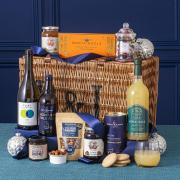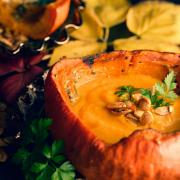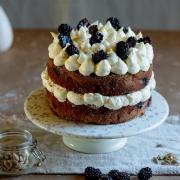As May is upon us, I thought I’d offer up some lighter dishes to you to help celebrate the sunshine (that I hope we will be having!).
As we get into the height of the summer, we move towards shellfish territory and I for one would happily have a crab every day for my dinner during the holidays season.
However, we have a few weeks before we get to that point, so here are some of my most precious recipes for your catch of the day.
I have used Norwich city centre fishmonger and game dealer Gary Howard for many years as do most independent restaurants in the area.
The Howard family have been selling fish and game from their gorgeous shop on Fye Bridge Street since 1889, and now they will even deliver to your door.
Fresh fish is one our most popular and requested cookery classes: budding chefs seem more nervous about cooking this ingredient than any other.
And yet it is one of the simplest of all ingredients to cook with, particularly if you get your fishmonger to do all the preparation for you.

Fish really is the ultimate in fast food; quick to cook, super tasty and has the added bonus of being really good for you (you’ll note the position of that fact on my list).
There is a golden rule that I have espoused over many years when teaching people how to cook: 'The more expensive an ingredient, the less you have to do to it'.
In other words, whether you’ve bought a beautiful tail of monkfish, are feeling flush and have bought yourself a piece of turbot or a Dover sole or even if you’ve picked up a couple of dabs for £2 from the beach hut, let the fish speak for itself.
If you look at the menus or recipes of the modern-day fish restaurants and chefs, they do just that: a simple piece of fresh fish, a sauce and a starch and a vegetable. That’s it. A great dish.
The old Polish proverb says it better than I ever could: 'Fish, to taste right, must swim three times. In water, in butter and in wine.' Let’s dive in.

Sole meunière recipe
I think this is my favourite dish in the world.
The word ‘meuniere’ means miller’s wife. In cooking parlance it involves dredging the fish in flour and frying in butter. You can add chopped fresh parsley and a few capers if you wish.
It’s the dish that set Julia Child, author of Mastering The Art of French Cooking, on her culinary path after she ate it at La Couronne Rouen in France. She described the meal as 'an opening of the soul and spirit'. The restaurant still offers a fix prix menu in her honour, offering exactly what she ordered in 1948, including oysters and sole meunière. Child presented French cooking to the American masses, transforming a nation’s tastes from peanut butter and jelly to a discovery of the French classics. She was one of the very first American TV chefs, her show The French Chef premiered in 1963: all inspired by this simple dish!
Makes two portions
Ingredients:
4 fillets sole or plaice, skinned (about 180g)
2 tbsp plain flour
Salt, white pepper
2 tbsp light olive oil or sunflower oil
100g butter, salted
½ lemon, juice only
Generous bunch of parsley, chopped
2 teaspoon small capers
Method:
1. In a large shallow bowl, season the flour with a little salt and white pepper. Toss the fish in the flour, coating well, and shake off any excess.
2. Heat the oil and 20g of the butter in a large frying pan. Add the fish and cook for two minutes.
3. Use a fish slice or large spatula to turn, then cook the other side for 1-2 mins until golden.
4. Remove the fish to a warmed plate.
5. Wipe out the pan with kitchen paper. Return the pan to the heat, then add the additional butter.
6. Heat until it melts and begins to turn light brown in colour, then mix in the lemon juice, parsley and capers, if using. Swirl in the pan for a few seconds, and pour over the fish.
7. Serve immediately. When working ‘on the stove’ at the restaurant, the aim was always to get the plate of fish in front of the customer with the butter still foaming. You need a very fast waiter!

Smoked Haddock, Fried New Potatoes, Curry Butter Sauce, Poached Egg recipe
Growing up in the Fens, we had very little access to fresh fish, however the fish and chip van that came round on a Friday night offered ‘wet fish for sale’. The reality was that the only thing on offer was ‘yellow fish’: brightly-dyed smoked haddock. My mum would poach this in milk and have it with Slimcea bread. This dish will grace a table at any time of day, breakfast, lunch or dinner.
Ingredients
Per person
1 fillet of naturally-smoked haddock, free from bones, with the skin on
Flour lightly and pan-fry in a little foaming butter, remove from the pan to keep warm
100g cooked new potatoes, fried in the same pan with a little butter, when golden brown, remove and keep with the fish
Curry butter sauce
1 glass white wine
2 finely diced shallots
A touch of curry paste
1 tablespoon of whipping or double cream
125g chilled butter
Method:
1. Place the shallots and wine into a saucepan, boil to reduce the volume by half.
2. Add the cream and the curry paste, stir in and bring to the boil.
3. Shake in the chilled butter.
4. Turn the heat down and stir. When the butter has melted, remove from the heat.
5. Place the fish on top of the fried potatoes.
6. Top with a poached egg and surround with the sauce.

Wing of skate, poached in cider with apple, spring onions and parsley recipe
People are most odd in so many ways. One of he more common dining foibles is an aversion to any bones at all. They can be eating the biggest piece of haddock from the local chippy, but if they happen to find a single bone, it’s game over: 'I can’t eat this! It’s full of bones!' Skate seems to suffer particularly in this respect, but I absolutely love it. The bones in the wing are actually cartilage, and many seasoned fishermen will just crunch right through them. It’s a really easy fish to fillet if you need to, and this is an unusual recipe, but it’s a bit of showstopper!
Makes two portions
2 wings of skate
4 spring onions
1 dessert apple
125ml cider
1 dessert spoon double cream
1 good bunch of roughly chopped flat leaf parsley
Method
1. To bone the skate, simply run a flexible knife down each side of the bone, taking off the fillet in one piece.
2. Roll the fillet.
3. Chop the spring onions.
4. Peel and core the apple, cut into small dice.
5. Pour the cider over the skate, add the onions and the apple.
6. Place in a moderate oven gas mark 4/180C for 15 minutes.
7. Remove the skate, add a dessertspoon of cream and the chopped parsley.
8. Return to the boil and pour over the fish.
Richard Hughes is chef director at The Assembly House Norwich and The Richard Hughes Cookery School, assemblyhoursenorwich.co.uk


























